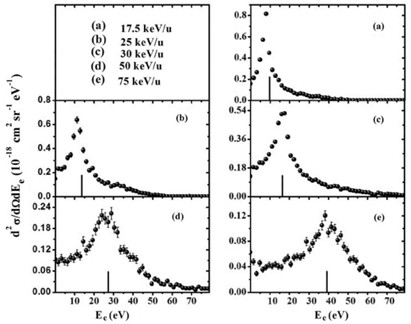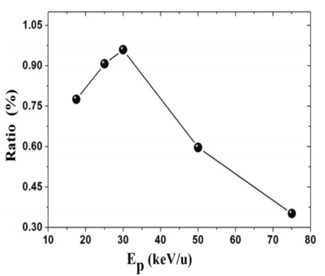Doubly differential cross sections (DDCS) for electron ejection provide valuable information about the physical mechanisms controlling the ionization processes, such as single ionization (SI) and transfer ionization (TI).
Most of the early experiments and quantum theories of the cusp shape focused on SI processes in which the cusp shape was considered as a smooth transition linking the electron captured to the bound states of the projectile and the continuum states of the target. Due to the experimental difficulties associated with measuring DDCS for two-electron transitions, the emission of cusp-shaped electrons has received little attention for TI.
The mechanism of cusp electron emission in the single electron transfer with single electron ionization of He2+on argon collision (T1I1) has been investigated by the researchers in Institute of Modern Physics, Chinese Academy of Sciences (IMP), using the cold target recoil ion momentum spectroscopy (COLTRIMS) apparatus at the 320-kV platform for multidiscipline research with highly charged ions.
Researchers presented the double differential cross sections for electron capture to the continuum of the projectile (cusp-shaped electrons) for collision energies from 17.5 to 75 keV/u, and obtained the dependence of the total cross sections of cusp electrons on the projectile energies.
Besides, researchers found that a velocity matching between the projectile velocity and orbital velocity of 3p electron of argon atom leads to the maximum of total cross section at the projectile energy of 30 keV/u. Since the electron-electron correlation in the present transfer ionization can be neglected, the T1I1 processes could be separated as two sequential processes of first ionization followed electron capture or first capture followed single ionization. The results show that the first ionization followed single capture processes is dominant in the cusp electron emission of the present transfer ionization process.
The results have been published in Physical Review A 87,012701.
The article can be linked as follows: http://pra.aps.org/abstract/PRA/v87/i1/e012701

Fig.1 The double differential cross sections of cusp electron emission in T1I1 transfer ionization processes (Image by IMP)

Fig. 2 The ratio of cusp electrons to the total electrons ejected in the transfer ionization. (Image by IMP)

